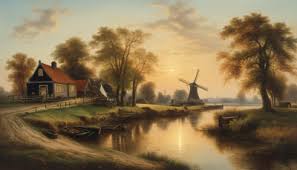Painting, one of the most ancient and revered art forms, has been a medium of expression for thousands of years. From the early cave schilderij of prehistoric times to the vibrant digital canvases of today, painting continues to captivate and inspire people across the globe. This article delves into the history, techniques, and significance of painting, illustrating why it remains a vital part of human culture.
A Brief History of Painting
The journey of painting began in the prehistoric era, with early humans creating images on cave walls using natural pigments. These primitive artworks, such as those found in Lascaux and Altamira, were not merely decorative but served as a means of communication, storytelling, and spiritual expression.
As civilizations progressed, painting evolved significantly. In ancient Egypt, artists used hieroglyphs and intricate symbols to narrate religious and historical events. Greek and Roman painters continued to advance the medium, emphasizing realism and human form, often on pottery and murals.
The Renaissance period marked a golden age for painting, characterized by a revival of classical ideals and techniques. Artists like Leonardo da Vinci, Michelangelo, and Raphael pushed the boundaries of realism, perspective, and human anatomy, producing masterpieces that are still celebrated today.
The 19th and 20th centuries saw a dramatic shift in painting styles, with movements such as Impressionism, Cubism, and Surrealism challenging traditional notions of representation. Artists like Claude Monet, Pablo Picasso, and Salvador Dalí explored new ways to convey emotion, perception, and the subconscious.
Techniques and Styles
Painting encompasses a wide range of techniques and styles, each offering a unique way to explore and express visual ideas. Some of the most notable techniques include:
- Oil Painting: Known for its rich texture and depth of color, oil painting allows for extensive blending and layering. Artists like Rembrandt and Van Gogh are famous for their mastery of this medium.
- Watercolor Painting: With its transparent and fluid qualities, watercolor is ideal for capturing delicate and spontaneous effects. Artists such as J.M.W. Turner and Winslow Homer are celebrated for their watercolor works.
- Acrylic Painting: This versatile medium dries quickly and can mimic the effects of both oil and watercolor paints. It is popular among contemporary artists for its adaptability and vibrant colors.
- Fresco: An ancient technique where pigments are applied onto wet plaster, fresco painting has been used in many historic buildings, including the Sistine Chapel.
Each painting style, from realism to abstract, serves a different purpose. Realist painters strive to represent the world as accurately as possible, while abstract artists focus on shapes, colors, and forms to convey emotions or concepts.
The Significance of Painting
Painting holds a profound significance in human culture and society. It serves as a mirror to history, capturing moments of joy, sorrow, conflict, and beauty. Paintings can convey complex ideas and emotions, provoke thought, and inspire change. They are not only a reflection of individual creativity but also a window into the cultural and social contexts of their time.
Moreover, painting can be a powerful tool for personal expression and therapy. Many find solace in the act of painting, using it as a means to process emotions and experiences. The creative process can be deeply therapeutic, offering a sense of accomplishment and self-discovery.
The Future of Painting
As technology continues to advance, the world of painting is expanding. Digital painting has emerged as a new frontier, allowing artists to create works on virtual canvases with innovative tools and techniques. This evolution presents exciting opportunities for experimentation and collaboration, blending traditional methods with modern technology.
Despite these changes, the essence of painting remains unchanged. It continues to be a medium through which individuals express their innermost thoughts and feelings, and it holds an enduring place in the human experience.
Conclusion
Painting is more than just a visual art form; it is a profound means of communication, expression, and reflection. From ancient cave paintings to contemporary digital works, painting has continuously evolved, yet its core purpose remains the same: to capture the human experience and convey it through the language of color and form. Whether through the brushstrokes of a master or the digital creations of a modern artist, painting remains a testament to the boundless creativity and depth of the human spirit.


